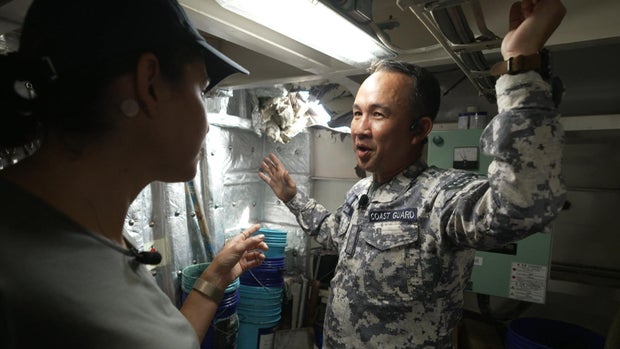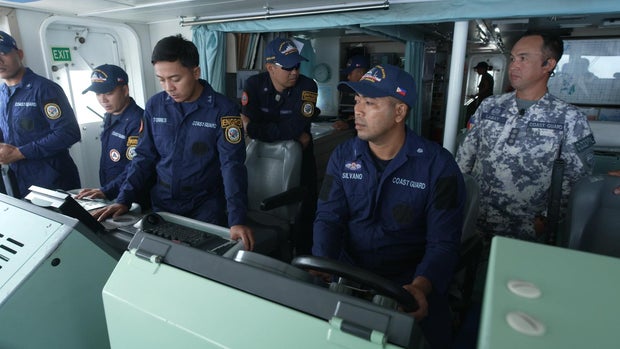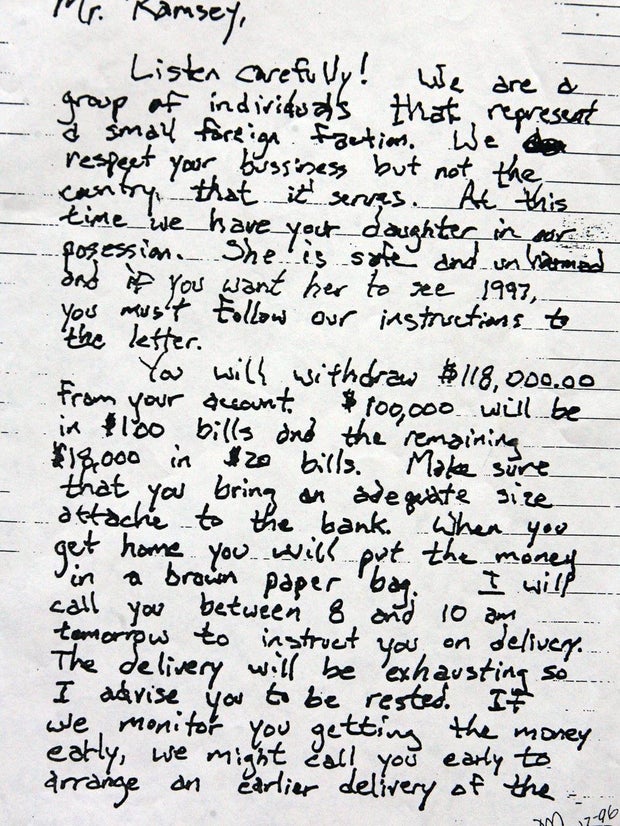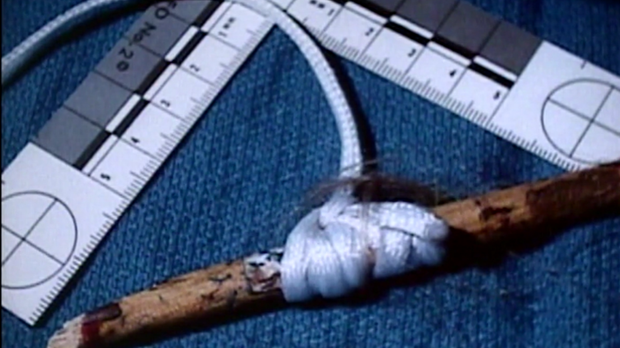CBS News
Why China rammed a Philippine ship while 60 Minutes was on board
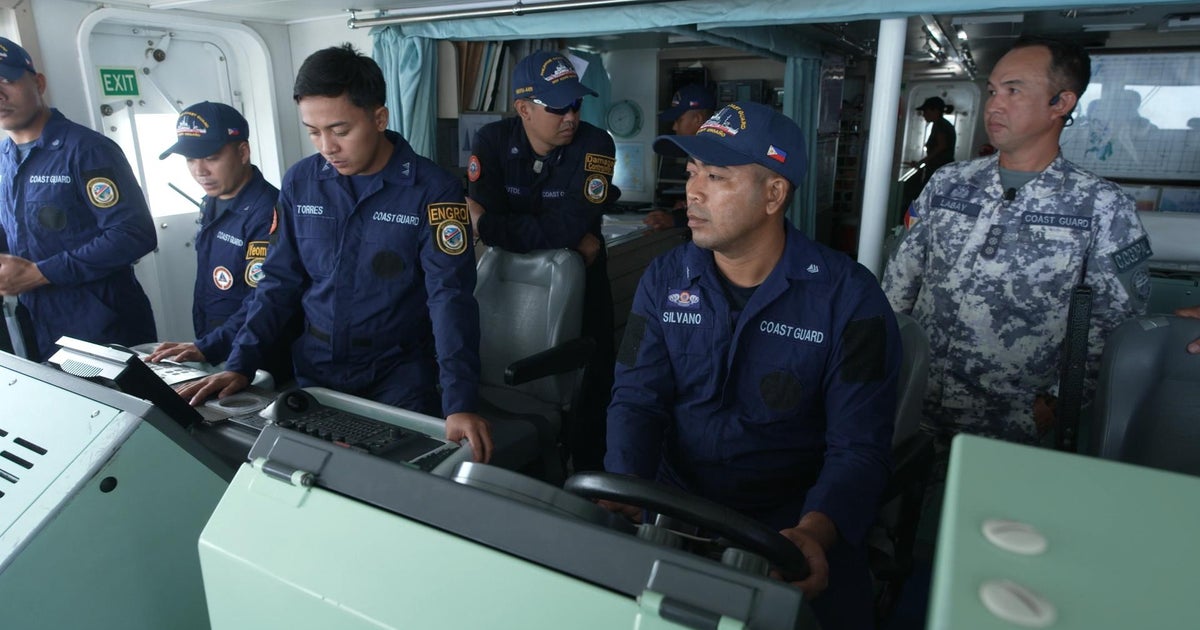
An escalating series of clashes in the South China Sea between the Philippines and China could draw the U.S., which has a mutual defense treaty with the Philippines, into the conflict.
A 60 Minutes crew got a close look at the tense situation when traveling on a Philippine Coast Guard ship that was rammed by the Chinese Coast Guard.
China has repeatedly rammed Philippine ships and blasted them with water cannons over the last two years. There are ongoing conversations between Washington and Manila about which scenarios would trigger U.S. involvement, Philippine Secretary of National Defense Gilberto Teodoro said in an interview.
“I really don’t know the end state,” Teodoro said. “All I know is that we cannot let them get away with what they’re doing.”
China as “the proverbial schoolyard bully”
China claims sovereignty over almost all of the South China Sea, through which more than $3 trillion in goods flow annually. But in 2016, an international tribunal at the Hague ruled the Philippines has exclusive economic rights in a 200-mile zone that includes the area where the ship with the 60 Minutes team on board got rammed.
China does not recognize the international tribunal’s ruling.
60 Minutes
“The proverbial schoolyard bully is the best example of what China is,” Teodoro said. “It just muscles you over.”
Ray Powell, a retired U.S. Air Force colonel, runs the nonprofit Sealight at Stanford University’s Gordian Knot Center for National Security Innovation, which tracks China’s actions in the South China Sea. He said China gets away with its actions because there is no enforcement.
“China has decided that at this point in their history, they are large enough so that they can buck the law,” Powell said.
60 Minutes crew witnesses violent tensions in the South China Sea
Just last month, a 60 Minutes crew witnessed the dangerous situation in the region.
Correspondent Cecilia Vega boarded the Cape Engaño, a Philippine Coast Guard ship, for what was supposed to be a routine mission resupplying ships and stations in the South China Sea. But sirens rang out in the middle of the first night at sea as they were en route to Sabina Shoal.
“It’s four in the morning,” Vega said from the ship. “We’ve all been sound asleep. This alarm just went off on the ship. We were told to wake up and put our life jackets on because we’ve just been rammed by a Chinese boat.”
The 60 Minutes crew was told to stay inside the cabin for safety. There was confusion and fear and it was unclear if the ship would take on water or if the Chinese would try to force their way on board. Philippine crew members prepared for that possibility and stood by the hatch holding clubs in case they had to fend off the Chinese.
60 Minutes
After the Chinese Coast Guard ship — 269 feet long and nearly twice the size of the Cape Engaño — pulled away, the Filipino crew found a three-and-a-half foot hole in the hull.
The ramming incident happened about 60 nautical miles off the coast of the Philippines and about 660 nautical miles from China.
As the day wore on, it became clear the Philippine ship was surrounded by Chinese vessels. Manila and Beijing have stationed coast guard vessels around an area called Sabina Shoal in recent months, with the Philippines fearing China will try to take control. The ship Vega and her team was on was headed to Sabina Shoal to resupply a Philippine coast guard ship there.
“We’re at a complete standoff. We’ve been here for, going on, two hours now, not moving,” Vega reported at the time. “It’s unclear whether we can even turn around and go back, if we wanted to. We’re just completely surrounded by Chinese ships.”
The Filipinos tried to negotiate a way out, but ultimately were forced to abandon the first stop of their mission. In their damaged boat, they had to take a long detour to their next supply drop, as Chinese ships followed closely.
By then, the Chinese had already publicized their version of the incident — accusing the Filipinos of instigating the conflict and highlighting the faces of the 60 Minutes crew, accusing them of being part of a propaganda campaign.
Cpt. Daniel Labay, the top-ranking officer on the Cape Engaño, said it was clear the collision was not his ship’s fault. He said the damage to the Cape Engaño would not stop it from continuing on.
“This is our place. This is our exclusive economic zone,” he said. “This is the Philippines.”
The most violent incident so far
The Sierra Madre, a grounded World War II-era battleship used to hold down Manila’s claim to another disputed area in the South China Sea, was the scene of the most violent incident to date.
In June, when the Philippine Navy tried to resupply troops stationed on the Sierra Madre, the Chinese tried to block the delivery. They had bladed weapons and spears with them, Gen. Romeo Brawner, the Philippines’ military chief of staff, said. A Filipino Navy SEAL lost his right thumb after the Chinese rammed his boat.
60 Minutes
“They stole our equipment. They destroyed our equipment. They hurt our personnel,” Brawner said. “These are the doings of pirates.”
If the Chinese were to open fire and the Filipinos fired back, it could mark the beginning of war, Brawner said.
American intervention would be expected if the Chinese took the Sierra Madre, Teodoro said.
“That is an outpost of Philippine sovereignty,” Teodoro said. “So we’re not talking about a rusty, old vessel solely. We’re talking about a piece of Philippine territory.”
The U.S. role in the China-Philippines conflict
The U.S. has a mutual defense treaty with the Philippines, which means the U.S. is bound to defend the Philippines if it comes under armed attack. If, in a future ramming incident, a Philippine ship sinks and people die, the Philippines may get onto a war footing and turn to the U.S., Powell said. It could hurt U.S. credibility with allied countries if it fails to meet its treaty obligations.
“Every treaty in the end depends on the political will of the parties,” Powell said.
Currently, the U.S. conducts regular joint exercises with the Philippines, though it has not had a permanent military presence in the country since 1992. This year the U.S. committed $500 million in military aid to the Philippines and another $128 million to upgrade bases.
60 Minutes
President Biden has invited Philippine President Ferdinand Marcos Jr. to the White House twice in the past 16 months and has assured him of America’s support. He has stressed that the U.S. commitment to the Philippines is “ironclad,”
Earlier this year, Washington sent the Philippines a powerful weapon during joint exercises – a mid-range missile system capable of reaching mainland China.
The move angered China.
“What happens within our territory, it is for our defense. We follow international law,” Teodoro said. “What’s the fuss?”
China says the Philippines is increasing the risk of war in the region.
“That’s what they always say,” Teodoro said. “Everything the world does that they don’t like is the fault of the world.”
CBS News
Government on track for shutdown after Trump-backed spending bill fails

Watch CBS News
Be the first to know
Get browser notifications for breaking news, live events, and exclusive reporting.
CBS News
Can the murder of JonBenét Ramsey be solved by 7 items of evidence?

The details of the murder are still shocking today, nearly three decades later. On Dec. 26, 1996, the 6-year-old daughter of John and Patsy Ramsey, a well-to-do couple living in Boulder, Colorado, was found dead in the family’s basement. JonBenét Ramsey, an outgoing child who performed in local beauty pageants, had been bludgeoned and strangled.
Polaris
It is a story I began covering for “48 Hours” in 1999 and will return to in “The Search for JonBenét’s Killer” airing Saturday, Dec. 21 at 10/9c on CBS and streaming on Paramount+. The program is a look back at how we covered the case in 2002. It’s a television time capsule, allowing viewers to hear Patsy and John Ramsey talk about their daughter and how her death and the following investigation upended their lives.
Shortly before 6 a.m. on the morning after Christmas, Patsy Ramsey called 911. She had awakened, she later told police, to find her daughter missing and a two-and-a-half-page note left on the stairs demanding a $118,000 ransom.
AP/Boulder Police Department
Despite a written warning not to notify anyone, the Ramseys called Boulder police, who searched their home and recommended the family wait for a call from the kidnappers. Later that day, a Boulder detective suggested John Ramsey and a family friend look through the home to see if anything looked out of place. When John Ramsey entered a room in the basement, he found his daughter dead on the floor, with a white blanket over her body and duct tape across her mouth.
The tragic discovery of the child by her own father, after officers had already searched the home, was the beginning of a yearslong, error-plagued investigation. JonBenét Ramsey’s murder was the first homicide that year in Boulder.
The case, after the acquittal of football star O.J. Simpson, immediately became the next international media sensation. Pictures of the photogenic 6-year-old competing in child beauty pageants appeared in the tabloids, while armchair detectives filled the airwaves, debating the contents of the ransom note.
Unidentified male DNA was left on the child and tests, performed just weeks after the murder, excluded anyone from the Ramsey family, including JonBenet’s 9-year-old brother Burke. Those results were initially kept from the press and public as investigators continued to focus mostly on John and Patsy Ramsey as suspects in their daughter’s murder.
While the couple gave DNA, hair, blood and writing samples in the days following the murder, they hired attorneys and didn’t speak to investigators until several months later, in April 1997, and again in June 1998. Video from that 1998 interrogation, aired publicly for the first time by “48 Hours,” shows a combative Patsy Ramsey denying any involvement in her daughter’s murder. When told that investigators had scientific trace evidence linking her, she responded, “That is totally impossible. Go retest.” She then added, “I don’t give a flying flip how scientific it is. Go back to the damn drawing board. I didn’t do it. John Ramsey didn’t do it. So we all got to start working together from here, this day forward to try to find out who the hell did it.”
In 2008, after more DNA tests again excluded the Ramsey family, the Boulder District Attorney at that time, Mary Lacy, publicly exonerated the Ramseys and sent them a letter of apology.
Investigators considered the theory that JonBenét may have been killed by an intruder, and over the years, looked at other persons of interest, including a neighbor who played Santa Claus and at least two people who confessed to the murder.
The only arrest in the case was made in 2006 after a man living in Thailand by the name of John Mark Karr claimed to have drugged, sexually assaulted and accidentally killed JonBenét. No drugs, however, had been found in the child and Karr’s DNA did not match what was left at the scene. Karr was later released.
Patsy Ramsey never lived to see the Boulder district attorney’s apology or have her name cleared. In 2006, she died, at age 49, of ovarian cancer. But John Ramsey, who remarried in 2011, has continued to push the Boulder police to find and arrest his daughter’s killer.
If JonBenét Ramsey had lived, she would have turned 34 years old in August. In an interview with “48 Hours” in November, John Ramsey said he can’t imagine his daughter as a grown woman, but only as a 6-year-old. He said he is confident that the unknown male DNA profile in the case will ultimately lead to a suspect in her murder. He is asking investigators in Boulder to turn over that DNA to an independent private lab that can employ the same technology, genetic genealogy, that was used to identify the Golden State Killer in 2018, and countless others since.
CBS News
Ramsey also said there are seven items of evidence from the family’s home that could still be tested for DNA including, he said, the garrote used to strangle JonBenét, a rope found in a guest bedroom, as well as a blanket. The Boulder Police Department, however, in a release in November, disputed Ramsey’s contention that they are not testing evidence.
“The assertion that there is viable evidence and leads we are not pursuing—to include DNA testing — is completely false,” read a Boulder Police statement. Still, in a nearly six-minute video that was also released, the current Boulder Police Chief Stephen Redfearn admits, “there were things that people have pointed to throughout the years that could have been done better and we acknowledge that is true.”
John Ramsey, who turned 81 in early December, has lived under a cloud of suspicion for nearly three decades, but he said the weight of constant public scrutiny was nothing compared to the loss of his child.
“It was just noise level stuff,” Ramsey said, “We were so devastated and crushed by the loss of JonBenét … it didn’t matter … it didn’t matter.”
He is speaking out now, he said, because an arrest in the case would finally give some peace to his son Burke, now in his 30s, and his two older children from his first marriage.
“… identifying the killer,” he said, “isn’t gonna change my life at this point, but it will change the lives of my children and my grandchildren. This cloud needs to be removed from our family’s head and this chapter closed for their benefit.”
In addition to fighting to keep his daughter’s case in the public eye, Ramsey is working to see the passage of The Homicide Victims’ Families’ Rights Act, which would allow a murder victim’s family to request a federal review of their case.
“That would be a huge step forward to fix a fundamental problem in our system in this country,” Ramsey said, “not a complete solution, but it’s a step forward.”
CBS News
7-year-old girl killed, 6 other people wounded in stabbing attack at school in Croatia, police say

Stipe Majic/Anadolu via Getty Images
A 7-year-old girl was killed and at least five other students and a teacher were wounded in a knife attack at a school in the Croatian capital, Zagreb, on Friday, police said. The local hospital said the wounded teacher had suffered life-threatening injuries, Reuters reported.
Officials said the attack happened at 9:50 a.m. local time at the Precko Elementary School in the neighborhood of the same name. They described the attacker as a “young male” and said he had been detained.
Croatia’s Interior Ministry said the attacker was 19 years old. Local media reported the attacker was a former student at the school, and showed video footage of children running away from the school building and a medical helicopter landing in the schoolyard.
Croatian Prime Minister Andrej Plenkovic said he was “appalled” by the attack, and that authorities are still working to determine exactly what happened. He said several children have been taken to various hospitals in Zagreb.
State television reported the attacker went straight into the first classroom he found after entering the school, where he attacked the students and their teacher.
School attacks are rare in Croatia. Last May, a teenager in neighboring Serbia opened fire at a school in the capital Belgrade, killing nine fellow students and a school guard.



